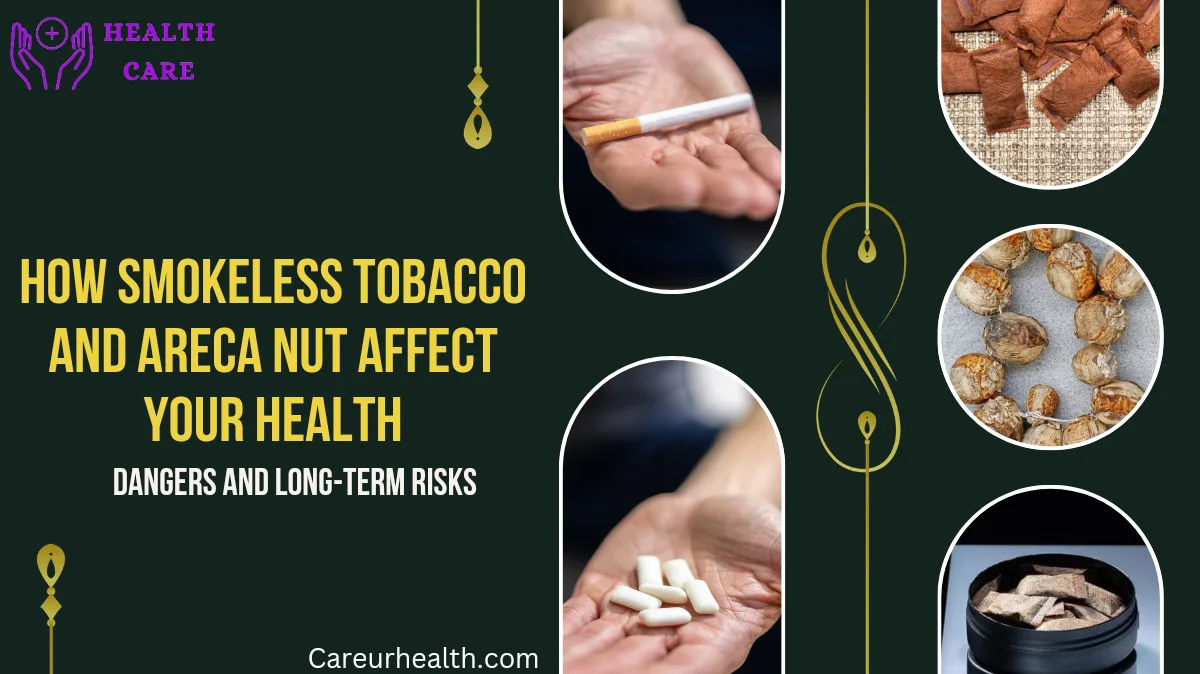Understanding Smokeless Tobacco and Areca Nut
What is Smokeless Tobacco?
Smokeless tobacco and its effect refers to products that are consumed without burning, such as chewing tobacco as well as snuff.
This method exposes users to significant health risks without the smoke associated with cigarettes. Smokeless tobacco usage may not produce smoke as well as but its effect on the heart is significant.
Key Takeaways
- Smokeless tobacco and areca nut consumption carry severe health risks.
- Addiction to these products can happen quickly due to high nicotine levels.
- Areca nut is classified as a carcinogen, with long-term usage causing severe damage.
- Smokeless tobacco leads to gum diseases, tooth decay, and other oral health problems.
Nicotine is the addictive component in tobacco, and in smokeless forms, its concentration is even higher than in cigarettes.
“This can lead to rapid dependence, making it difficult for users to quit. The harmful chemicals present in smokeless tobacco are absorbed through the mucous membranes, leading to several oral health issues, including gum disease and cancer.”
How Smokeless Tobacco and Areca Nut Affect Your Health: Dangers and Long-Term Risks
Smokeless tobacco and areca nut are widely consumed in various cultures, especially in regions like South Asia. However, both substances carry significant health risks that should not be overlooked.
The dangers associated with these products range from oral cancer to addiction, making them hazardous for long-term health. Smokeless tobacco usage may not produce smoke as well as but its effect on the heart is significant.
In this section, we will explore the immediate and long-term health effects of smokeless tobacco and areca nut use. The harmful effect of smokeless tobacco on the gums can lead to disease.
The Composition and Use of Smokeless Tobacco and Areca Nut
Smokeless Tobacco: What is it?
It is usually available in two forms: chewing tobacco and snuff. Unlike smoking, where the tobacco is burnt, smokeless tobacco is absorbed through the mucous membranes in the mouth. Despite the absence of smoke, smokeless tobacco is far from harmless.
- Contains nicotine, a highly addictive substance.
- Often laced with various chemicals, which enhance its addictive properties.
- Prolonged use is linked to various cancers, including oral cancer.
- Smokeless tobacco is culturally accepted in some regions, which contributes to its widespread use.
Areca Nut: A Common Cultural Practice
While it holds cultural and social significance in many parts of Asia as well as the Pacific, its health risks are severe:
- The alkaloids in areca nut are addictive, similar to nicotine.
- Classified as a carcinogen by health organizations.
- It contributes to diseases such as oral submucous fibrosis, a precancerous condition that can eventually lead to mouth cancer.
Health Risks: Immediate Effects on the Body
Oral Health Complications
The first area of the body to suffer from smokeless tobacco and areca nut use is the mouth. The chemicals present in both substances can irritate the mouth’s soft tissues and lead to:
- Gum recession, where the gums pull away from the teeth, exposing the roots.
- Development of white patches, known as leukoplakia, which can become cancerous over time.
- Users frequently experience bad breath, which impacts personal interactions.
- Areca nut users often suffer from stained teeth as well as a cosmetic but persistent side effect.
Areca Nut: A Hidden Danger
The areca nut, often consumed with smokeless tobacco, is another significant health risk. The harmful effect of smokeless tobacco on the gums can lead to disease. Many are unaware of the long-term effect of smokeless tobacco on oral tissues.
In many cultures, this practice is traditional, but the long-term health effects are devastating.
The areca nut has been classified as a Group 1 carcinogen by the World Health Organization (WHO). Long-term use increases the risk of oral cancer, submucous fibrosis (a condition that restricts mouth opening), and other severe diseases.
Regular users often experience addiction, leading to prolonged exposure to harmful toxins. Smokeless tobacco usage may not produce smoke, but its effect on the heart is significant.
Understanding the Problem: A Growing Concern
Overview of Smokeless Tobacco and Areca Nut Use
Smokeless tobacco and areca nut use have become increasingly prevalent, especially in South Asia and parts of Africa. Both of these products are commonly used in chewing form and are often perceived as safer alternatives to smoking.
However, these substances pose serious health risks, and their use can lead to dangerous long-term health outcomes, including cancer, cardiovascular disease, and oral health deterioration.
Smokeless tobacco includes products such as snuff as well as chewing tobacco, while areca nut is often consumed with betel leaf. These products are highly addictive and are linked to severe diseases.
Nicotine in smokeless tobacco can lead to addiction, while areca nut is classified as a carcinogen by the World Health Organization (WHO). Despite being used widely in cultural practices, both products have harmful consequences. The harmful effect of smokeless tobacco on the gums can lead to disease.
Health Risks of Smokeless Tobacco: Immediate and Long-Term
Short-Term Health Impacts
Smokeless tobacco has immediate negative effects on oral and general health.
- Gum recession is a common issue among smokeless tobacco users, as the chemicals erode the gums.
- Users may experience bad breath as well as discolored teeth, both of which contribute to poor oral hygiene.
- The high nicotine content can cause an increased heart rate, leading to a higher risk of cardiovascular complications. Smokeless tobacco usage may not produce smoke, but its effect on the heart is significant.
- Chewing tobacco can result in mouth sores, a precursor to more severe health complications.
- Prolonged use increases the risk of oral cancer, even in younger individuals.
Smokeless tobacco also contributes to systemic diseases such as hypertension and increased risk for strokes.
The continuous absorption of toxic chemicals into the bloodstream places immense pressure on the cardiovascular system, significantly increasing mortality risk. The harmful effect of smokeless tobacco on the gums can lead to disease.
Long-Term Health Risks
The long-term risks associated with smokeless tobacco are severe. These include:
- Oral cancer: Long-term use of smokeless tobacco is strongly associated with an increased risk of oral cancers, including cancers of the lips, tongue, and throat.
- Periodontal disease: Regular use leads to chronic gum disease, which can result in tooth loss and further oral health complications.
- Pancreatic cancer: Studies have shown a direct link between smokeless tobacco use and an increased risk of pancreatic cancer, due to the toxins absorbed into the bloodstream.
- Addiction: The nicotine content in smokeless tobacco makes it highly addictive, trapping users in a cycle of continued use.
- Esophageal issues: Continuous exposure to harmful chemicals can cause long-term damage to the esophagus, leading to cancer or other severe health conditions. Many are unaware of the long-term effect of smokeless tobacco on oral tissues.
Areca Nut: Cultural Use and Hidden Dangers
Areca Nut Consumption and Social Acceptance
However, despite its widespread acceptance, areca nut is not safe for long-term use. It has been classified as a carcinogen, as well as regular consumption leads to multiple health problems:
- Submucous fibrosis: This painful condition makes it difficult to open the mouth and can lead to permanent disability.
- Oral cancer: Similar to smokeless tobacco, areca nut significantly increases the risk of cancers in the oral cavity.
- Addiction: Areca nut contains alkaloids that cause addiction, making it difficult for users to quit despite the health risks. The harmful effect of smokeless tobacco on the gums can lead to disease.
- Stained teeth and bad breath are common cosmetic consequences of chewing areca nut, impacting users’ appearance and social interactions.
- Continuous use can lead to esophageal issues, resulting in severe discomfort and long-term digestive problems.

Global Health Responses to the Issue
Public Health Campaigns and Regulatory Efforts
In recent years, global health organizations like the WHO have been raising awareness about the dangers of both smokeless tobacco as well as areca nut consumption. Smokeless tobacco usage may not produce smoke, but its effect on the heart is significant.
Educational campaigns highlight the risks and provide resources for quitting. Efforts include:
- Warning labels on packaging to inform users of the potential health hazards. Many are unaware of the long-term effect of smokeless tobacco on oral tissues.
- Public awareness campaigns that educate about the long-term risks of tobacco and areca nut use.
- Support programs for those struggling with addiction, providing resources such as counseling and nicotine replacement therapies.
- Governments in many countries are implementing higher taxes on these products to reduce accessibility.
- Some countries have outright banned the sale of certain smokeless tobacco and areca nut products in an effort to curb use.
Health Risks of Smokeless Tobacco and Areca Nut Use
Immediate Effects
Users may experience.Smokeless tobacco has a profound effect on oral health. Many are unaware of the long-term effect of smokeless tobacco on oral tissues.
- Stained teeth due to the chemicals present in tobacco and areca nut.
- Bad breath that persists despite oral hygiene efforts.
- Increased risk of gum disease and oral infections.
- Addiction due to the high nicotine content in smokeless tobacco.
- Drying of the mouth and frequent mouth sores due to continuous exposure to harmful substances.
Long-Term Health Consequences
The long-term use of smokeless tobacco as well as areca nut poses significant health risks, including. Many are unaware of the long-term effect of smokeless tobacco on oral tissues:
- Oral cancer: Users are at a much higher risk of developing cancers of the mouth, tongue, and throat.
- Submucous fibrosis: This painful condition causes a tightening of the mouth tissues, making it difficult to open the mouth or eat.
- Gum diseases: Chronic use leads to periodontitis, which causes gums to recede, exposing tooth roots as well as leading to tooth loss.
- Heart disease: Smokeless tobacco can increase heart rate and blood pressure, raising the risk of heart attacks. Smokeless tobacco usage may not produce smoke, but its effect on the heart is significant.
- Addiction: Due to high nicotine levels, users often struggle to quit, leading to prolonged health risks.
Societal Impact and Public Health Concerns
Smokeless Tobacco in Different Cultures
In many parts of Asia and Africa, smokeless tobacco and areca nut use is widespread as well as ingrained in cultural traditions. Smokeless tobacco has a profound effect on oral health.Many are unaware of the long-term effect of smokeless tobacco on oral tissues.
The social acceptability of these substances often masks the severe health risks they pose. Governments and health organizations are working to raise awareness about the dangers of these products through public health campaigns.
Despite these efforts, many users are unaware of the severe long-term consequences, leading to continued use, particularly in rural areas. The addiction associated with smokeless tobacco and areca nut makes quitting difficult, especially in communities where these products are readily available and socially acceptable.
Health Campaigns and Regulatory Efforts
Global Efforts to Curb Smokeless Tobacco Use
International organizations such as the WHO have classified both smokeless tobacco and areca nut as serious public health risks. Smokeless tobacco has a profound effect on oral health.
There are ongoing efforts to regulate the sale and marketing of these products, particularly in countries where they are most prevalent. Public health campaigns aim to educate users on the dangers of continued use and offer resources for quitting.
In some countries, smokeless tobacco and areca nut use is restricted through taxation, warning labels, and bans on advertising. However, enforcement of these laws is inconsistent, and many users continue to access these harmful products.
Conclusion
Both smokeless tobacco and areca nut pose significant health risks, including the development of oral cancers, cardiovascular diseases, as well as addiction.
Despite cultural acceptance in many regions, the long-term dangers far outweigh any temporary satisfaction. Public health initiatives must continue to raise awareness and provide support for those wishing to quit.
It is crucial for governments and health organizations to work together to restrict access to these harmful substances. Many are unaware of the long-term effect of smokeless tobacco on oral tissues.
FAQs
1. How does smokeless tobacco affect oral health?
Smokeless tobacco can cause gum disease, tooth decay, as well as oral cancers, significantly damaging oral health. Smokeless tobacco has a profound effect on oral health.
2. Is areca nut a carcinogen?
Yes, the areca nut has been classified as a Group 1 carcinogen by the WHO, meaning it is known to cause cancer in humans.
3. Can smokeless tobacco cause cancer?
Yes, long-term use of smokeless tobacco increases the risk of developing cancers of the mouth, throat, and esophagus.
4. Why is it difficult to quit using smokeless tobacco?
The high levels of nicotine in smokeless tobacco make it highly addictive, leading to dependence and difficulty in quitting.
5. Are there any public health campaigns addressing this issue?
Yes, organizations like the WHO and local governments run campaigns to educate people on the dangers of smokeless tobacco and areca nut use.










